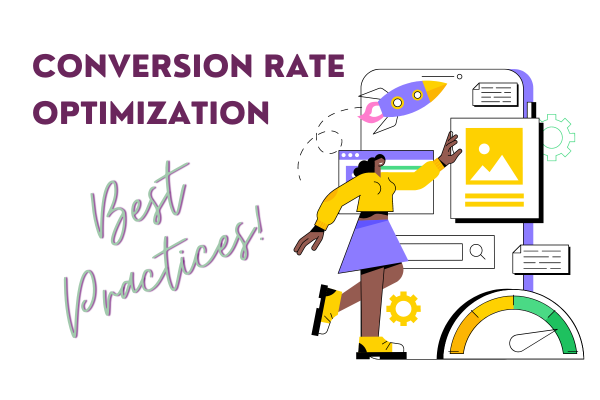CRO Best Practices to Immediately Boost Conversions on Your Website
In some ways, a website is similar to a brochure but even better. It introduces your organization to customers and explains what you do. But there is something a website can do better than even the best static print collateral — and that is to drive conversions.
Through buttons, opt-ins, and forms, website elements can invite audiences to take action and connect with your brand while visiting your website — and this can have major implications for your business. More conversions mean more customers.
Let’s walk through the steps of optimizing your website to drive more conversions and move more customers closer to working with your brand.
What Is a Conversion?
A website conversion occurs when a website visitor takes a desired action. The action is tied to a measurable goal and represents a moment when a prospect or customer moves one step further in the sales funnel.
Website conversions vary based on goals and sales funnel strategies. Website audiences are typically directed to complete a conversion through language known as a call-to-action (CTA).
Examples include:
Click to watch a video
Download a gated content asset
Share a link or piece of content
Complete a survey or quiz
Sign up for a newsletter or offer
Register for an event
Fill out a contact form
Request a demo
Sign up for a free consultation
Make a purchase
What Is Conversion Rate?
A conversion rate is how you measure the success and effectiveness of a conversion action. A conversion rate represents the percentage of website visitors who take a desired action out of the total number of website visitors.
Conversion Rate =
(Number of Conversions / Number of Website Visitors) X 100
For example, 1,000 people visit a webpage with a CTA to sign up for a webinar, and 45 people sign up. The conversion rate would be 4.5%.
What Is Conversion Rate Optimization (CRO)?
Conversion rate optimization is updating and testing website elements to motivate more audiences to take action and trigger more conversions. The more conversions that take place, the higher your conversion rate will be.
For CRO, it helps to have a benchmark to measure your efforts. Conversion rates vary heavily based on industry and type of conversion. A good starting benchmark for a conversion rate is roughly 2-5%. To find a more accurate benchmark, research your particular industry and type of conversion (lead gen conversion, purchase conversion, etc.).
How to Improve Conversion Rates on Your Website
More conversions and a high conversion rate have obvious benefits: more leads and more customers. If you’re using your website for lead generation and sales, it’s important to engage in conversion rate optimization tactics to continuously improve and boost effectiveness.
Here are a few ways to improve conversions on your website.
1. Make sure your website is ready to welcome visitors.
Even the best conversion optimization strategies will struggle to drive results if a website does not meet standard best practices. Before you optimize your website, make sure it meets website standards for design, user experience, messaging, software, and functionality.
Related: 5 Reasons to Consider a Website Redesign & 3 Easy Ways to Get Started
2. Map a sales funnel with clear call-to-actions.
An effective conversion optimization strategy starts with a strong sales funnel. When you have proper buyer personas and journey mapping, you can identify the conversions that need to take place.
Using your sales funnel, define what action needs to take place in each phase and the call-to-action that will drive website visitors to take that action. For example, in the awareness phase, the CTA may be to sign up for a newsletter. In the consideration phase, the CTA may be to request a free demo.
Related: Create a Better B2B Ad Strategy by Focusing on The Buyer’s Journey
3. Assign a conversion point for each webpage.
When you know what you want website audiences to do and when you want them to do it, identify the places on your website where you can include relevant CTAs.
Outline a workflow for your website. Match pages on your site to sections of the sales funnel and define the path you want website visitors to take once they land on your site. Add relevant CTAs that move audiences through your funnel. For example:
A blog post in the awareness phases may include a CTA to sign up for a newsletter.
A home page in the interest phase may include a CTA to watch a welcome video.
A pricing page in the consideration phase may include a CTA to request a free demo.
A sales page in the purchase phase may include a CTA to buy now.
Related: B2B Website Content: What Pages Every Site Needs to Succeed
4. Consider your traffic sources.
To effectively optimize on-site conversions, you can’t only think about the page featuring a call-to-action. You also need to think about the page that came before it.
Review the traffic sources leading visitors to web pages featuring strong call-to-actions to make sure audiences are properly primed to receive your messaging. For example, if you run ads to a landing page with a CTA to get a free demo of a SAAS tool, your ad copy must accurately reflect the messaging on the landing page to drive higher conversions.
5. Collect and review website data.
At the heart of conversion rate optimization is data. If you don’t have data to track your conversion rates, it will be difficult to know if your efforts are leading to higher or lower click-through rates.
Data tracking can also help you identify pitfalls and opportunities related to your conversions. You can see where users are getting stuck and find ways to move them through the process.
Set up conversion funnels and event tracking using Google Analytics and Tag Manager.
Review website analytics for bounce rates, time-on-page, and exit pages.
Analyze page paths to understand how users click through your website.
Use heatmaps to see where users are hovering and clicking.
Record visitor sessions to see how users navigate your site.
Conduct surveys and collect user feedback.
6. Test, test, test.
Collecting data is essential because it allows you to execute this next conversion rate optimization tactic: testing. Never assume that the conversion point you are currently using is the best you can do. Instead, run tests to see if you can increase conversion rates by making changes to elements such as:
Styles of CTAs (text-based, graphics, pop-ups, etc.)
Copy and messaging
Imagery and graphics
Offers
Button copy and colors
Forms options
Page layout
Related: The 8 Critical Dos and Don’ts of Website Maintenance
Is Your Website Optimized for Conversions?
A website should be one of your most significant marketing and sales assets. If your website is not driving engagement, leads, or sales, let’s talk.
Our team of website strategy specialists can audit your existing website to identify potential pitfalls and opportunities that can improve conversion rates and drive more leads and customers to your business. Learn more about our website design and optimization services. Or contact us today to get started.

